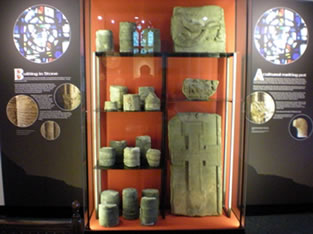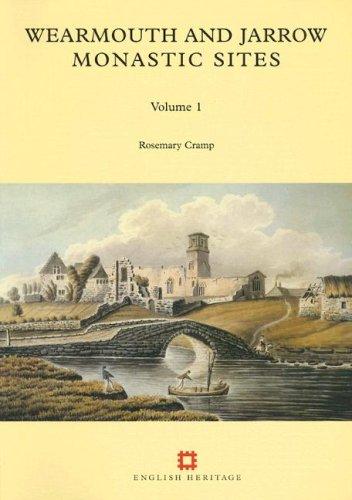Delving Deep Into The Past of St. Peter’s
Artefacts from the excavations of St. Peter’s monastery by Professor Dame Rosemary Cramp of Durham University between 1963 and 1978 can be seen on display in the St. Peter’s Church exhibition area. There are also artefacts in the corridor leading East from the church to the Chapter House where Bede’s Bakehouse is located.

Some important carvings remain within the stone fabric of the church.
Carvings within the porch to the west facade of the church can be seen from the outside.
The deposits on display in the exhibition area are not just of stone, but some of the 7th century coloured glass recovered from the site can be seen also, as well as pieces of the plaster work from the walls of the monastery.
Of particular importance is the reconstruction of the abbot’s throne, which identifies St. Peter’s as the seat of the abbots of Wearmouth-Jarrow. In the modern day, universities refer to a chair as a position of teaching authority and, with the juxtaposition of St. Peter’s Campus in the University of Sunderland to the present day site, we see that the place remains a place of learning to the present time.

Prior to Professor Cramp’s excavations little was known of the physical evidence that remained of buildings that were described in Venerable Bede’s written references. However, the exact location of the buildings, their heights, their construction were deeply uncertain so an open mind was needed. It was certainly important that as the ancient monastery was home to 400 monks that it was substantial and may have covered an extensive area.

Vols 1 and 2 by Professor R. Cramp (English Heritage)
During the excavations, some of the earliest stained glass in Britain were discovered. The deposits of glass found compromises the largest collection of seventh and eighth-century stained glass in Western Europe. When recalling the excavations one day, Professor Cramp described the moment she first saw them saying that the shards of glass “looked like jewels lying on the ground.”
For a complete photographic record of the archaeology of site, see.” Wearmouth and Jarrow Monastic Sites” Vols 1 and 2 by Professor R. Cramp (English Heritage) ISBN 10 1873592930 and 1873592949.
The churchyard and grounds contains internationally important archaeological remains of the Monkwearmouth Anglo-Saxon monastery and Medieval Priory Scheduled Monument. These remains are irreplaceable and are an extremely valuable educational resource.
Any works that would affect the scheduled monument will require Scheduled Ancient Monument consent.
The excavations undertaken at St Peter’s demonstrated good preservation of most types of archaeological remains. Changes in ground conditions and
potential for disturbance are considered minimal, not least because the site is overlain by deep ballast deposits which have the effect of conserving these deposits at low levels. Accordingly, archaeology across the site has exceptional future potential.
More lies buried under the St.Paul’s and St.Peter’s sites – work for future archaeological investigations.